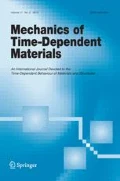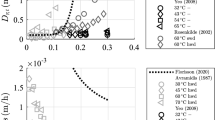Abstract
Creep evolution of timber structures results from the interaction between mechanical stresses due to different loads and hydric stresses due to moisture content variations. This paper deals with a thermodynamic approach in order to take into account a realistic elastic behavior under moisture content variations. In this context, memory effect, experimentally observed, is introduced employing a mechano-sorptive stress driven by a function dependent of the moisture content variations. This new internal thermodynamic variable enables to define an original separation of the free energy into an instantaneous recoverable part and a stored part during the last drying phase. This energy enables the modeling of the nonreversible strain process during the unloading phase. The locate state method is employed in order to define the thermodynamic function which traduces an indirect hereditary behavior between moisture content history and the stress state in the material.
Similar content being viewed by others
References
Bazant, Z.P.: Thermodynamics of solidifying or melting viscoelastic material. J. Eng. Mech. Div. 105(EM6), 933–955 (1979)
Bazant, Z.P.: Constitutive equation of wood at variable humidity and temperature. Wood Sci. Technol. 19, 159–177 (1985)
Bazant, Z.P., Carol, I.: Viscoelasticity with aging caused by solidifying of nonaging constituent. J. Eng. Mech. Div. 119(11), 2252–2269 (1993)
Chassagne, P., Bou-Saïd, E., Julien, J.F., Galimard, P.: Three dimensional creep model for wood under variable humidity-numerical analyses at different material scales. Mech. Time-Depend. Mater. 9, 203–223 (2006)
Dubois, F.: Modélisations numériques des comportements viscoélastiques vieillissants des matériaux du génie civil. Habilitation à Diriger des Recherches, University of Limoges (2004)
Dubois, F., Randriambololona, H., Petit, C.: Creep in wood under variable conditions: numerical modeling and experimental validation. Mech. Time-Depend. Mater. 9, 173–202 (2005)
Gril, J.: Une modélisation du comportement hygro-rhéologique du bois à partir de sa microstructure. Thesis, Ecole Polytechnique, University of Paris VI, Paris (1988)
Gril, J.: Principles of mechano-sorption. In: International COST 508 Wood Mechanics Conference (1996)
Grossman, P.U.A.: Requirements of models that exhibit mechanosorptive behavior. Wood Sci. Technol. 10, 163–168 (1976)
Habeger, C.C., Coffin, D.W., Hojjatie, B.: Influence of humidity cycling parameters on the moisture-accelerated creep of polymeric fibers. J. Polym. Sci., B, Polym. Phys. 39, 2048–2062 (2001)
Hanhijarvi, A.: Modeling of creep strain mechanism in wood. Thesis, Espoo University, Finland (1995)
Hanhijarvi, A.: Advances in the knowledge of the influence of moisture changes on the long-term mechanical performance of timber structures. Mater. Struct. 33, 43–49 (2000)
Hanhijarvi, A., Hunt, D.: The viscoelasticity of wood at varying moisture content. Wood Sci. Technol. 32, 57–70 (1998)
Haslach, H.W.: Time-dependent mechanisms in fracture of paper. Mech. Time-Depend. Mater. 13, 11–15 (2009)
Hunt, D.: Creep trajectories for beech during moisture changes under load. J. Mater. Sci. 19, 1456–1467 (1984)
Hunt, D.: Longitudinal moisture-shrinkage coefficients of softwood at the mechanosorptive creep limit. Wood Sci. Technol. 22, 199–210 (1988)
Lemaitre, J., Chaboche, J.L.: Mécanique des Matériaux Solides, Dunod, Paris (1988)
Martensson, A.: Mechanical behavior of wood exposed to humidity variation. Thesis, Lund University, Sweden (1992)
Mukuday, S., Yata, S.: Modeling and simulation of viscoelastic behavior (tensile strain) of wood under moisture change. Wood Sci. Technol. 20, 335–348 (1986)
Pittet, V.: Etude expérimentale des couplages mécanosorptifs dans le bois soumis à variations hygrométriques contrôlées sous chargement de longue durée. Ph.D. Thesis, Ecole Polytechnique Fédérale de Lausanne (1996)
Randriambololona, H.: Modélisation du comportement différé du bois en environnement variable. Ph.D. Thesis, University of Limoges (2003)
Ranta-Maunus, A.: The viscoelasticity of wood at varying moisture content. Wood Sci. Technol. 9, 189–205 (1975)
Salin, J.G.: Numerical prediction of checking during timber drying and a new mechanosorptive creep model. Holz Roh Werkst. 50, 195–200 (1992)
Toratti, T.: Creep of timber beams in variable environment. Ph.D. Thesis, Helsinki University of Technology (1992)
Author information
Authors and Affiliations
Corresponding author
Rights and permissions
About this article
Cite this article
Husson, J.M., Dubois, F. & Sauvat, N. Elastic response in wood under moisture content variations: analytic development. Mech Time-Depend Mater 14, 203–217 (2010). https://doi.org/10.1007/s11043-009-9104-y
Received:
Accepted:
Published:
Issue Date:
DOI: https://doi.org/10.1007/s11043-009-9104-y




